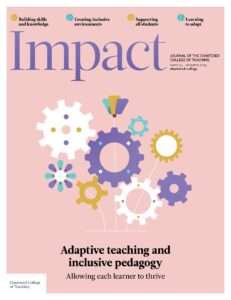Moving from traditional differentiation to adaptive teaching: A case study

LEANNE LOWE, DEPUTY HEADTEACHER, MESAIEED INTERNATIONAL SCHOOL, QATAR
In recent years, educational thinking around the topic of differentiation has evolved significantly. Most notably, this is evidenced in the initial teacher trainingAbbreviated to ITT, the period of academic study and time in school leading to Qualified Teacher Status (QTS) and early career framework (DfEDepartment for Education - a ministerial department responsible for children’s services and education in England, 2024), which outlines the aspects that new teachers need to know and the skills that new teachers need to have with regard to adaptive teaching. The shift is significant, not least because the majority of the current education workforce will have spent a large proportion of their career receiving and giving evidence-based advice to differentiate. This study explores one school’s approach to developing thinking around and practice for providing for differing needs and starting points within the classroom. It examines how Mesaieed International Primary School, a large multi-cultural, multilingual, British-curriculum school, has redefined its teaching practices to align with the evolving discourse on adaptive teaching, having worked extensively on developing a collective understanding of Quality First Teaching, using Rosenshine’s principles of instruction (2012), in previous school development cycles.
When taking the first steps into adaptive teaching, the school used three sources to frame thinking: standard 5 in the early career framework (DfE, 2019); a guest blog for the Education Endowment Foundation authored by Jon Eaton, Director of Kingsbridge Research School and Research Lead at Kingsbridge Community College (2022); and the associated resource ‘Understanding adaptive teaching’ from Education South West (2022). The school had already adopted a ‘teaching for mastery’ pedagogy for mathematics, so teachers were familiar with the concept of universal design for learning and had moved significantly away from traditional methods of differentiation in mathematics. However, in other areas of the curriculum, this was not the case, particularly in terms of task design. Initial professional development sessions to explore the idea of adaptive teaching focused on a review of the school’s rubric for raising the standard of universal provision – namely Rosenshine’s principles of instruction (2012). Through this revisiting of Rosenshine’s principles, there was analysis of the opportunities that the principles offered to adapt teaching and to be responsive when a need was identified. Looking at them alongside the resource from Education South West led the school’s leadership team to our earliest definition of adaptive teaching: anticipating barriers to student learning, planning to address them, and responding and adapting during lesson delivery.
Following further professional development sessions, including a focus on strategies for language acquisition – a key priority for the school – initial monitoring and evaluation processes began of the school’s early implementation of adaptive teaching. Observations during learning walks and subsequent feedback highlighted that, at this stage, teachers were making adaptations because they had been asked to, and not because they had a clear understanding of what should or could be adapted. Feedback through staff voice sessions and individual conversations revealed frustration and confusion. As a school, we recognised that there was a clear requirement for regrouping and clarification at leadership level, as teachers had not been adequately prepared for implementation. In January 2024, a leadership team member taught demonstration lessons in English and mathematics for the rest of the leadership team. These lessons were carefully designed, adhering to National Curriculum objectives and incorporating advice from the SENDCo (special educational needs coordinator) and language lead. While the mathematics lesson was unanimously recognised as embodying adaptive teaching, post-lesson discussion among the leadership team around the English lesson revealed divergent views on what constituted appropriate adaptation. This underscored the need for further shared understanding of adaptive teaching, both across the school and also, critically, within the leadership team. The school’s leadership team worked collaboratively to craft a more illustrative definition of adaptive teaching. Subsequently, staff were provided with specific criteria to guide their practices, with a return to the school’s definition of Quality First Teaching, putting this at the forefront of the definition. Observations in this phase showed a greater emphasis on Quality First Teaching and signature pedagogies, although gaps in addressing certain individual needs remained.
In the following term, alongside ongoing language acquisition CPD (continuous professional development), the school introduced dyslexia and attention deficit hyperactive disorder (ADHD) training, identifying individual pupils as focus students with whom to explore adaptive strategies moving forwards. This approach had both strengths and challenges. Strengths were that individual needs were considered more effectively, specific CPD enhanced awareness and provision for individual needs, and there was greater classroom inclusionAn approach where a school aims to ensure that all children are educated together, with support for those who require it to access the full curriculum and contribute to and participate in all aspects of school life and responsiveness. Conversely, adapted resources were sometimes globally applied, limiting learning for others, and some adaptations remained unnecessary or arbitrary. The most effective adaptations occurred in year groups where leadership and teachers collaborated closely on weekly planning. Purposeful collaborative sessions focused on identifying potential barriers to learning during the planning phase, rather than focusing on task design. Furthermore, effective practice was seen when scaffolds were used strategically, with clear expectations for students to progress beyond them. Incorporating target questions for specific pupils in planning was reported to be effective in terms of access, inclusion and engagement.
At the start of this academic year, there was recognition among the leadership team that the approach of identifying focus students for adaptive teaching strategies, while having a number of positive elements, had inadvertently detracted from the notion of universal provision and a quality offer for all students. There was the necessity again to redefine the approach, and gap analysis of the previous academic year’s data further shaped the school’s thinking. The focus shifted towards a more data-driven methodology, emphasising larger-scale adaptations to teaching sequences. Data was used to identify challenges impacting all students, groups with prerequisite skill gaps and specific individuals, allowing for more targeted adaptations at the planning stage. Furthermore, the ideology was revisited with teachers in sessions where they critically evaluated traditional methods of differentiation, such as fixed ability groups and differentiated worksheets, among others. Staff were tasked with proposing more effective alternatives to these outdated practices. This exercise, combined with the leadership team’s efforts to refine the school’s definition of adaptive teaching, has provided a solid foundation for sustained improvement in teaching practices – with, of course, more work to be done.
In summary of the process, from inception to current position, it is clear that early implementation revealed a lack of clarity and consistency in adaptive strategies, as highlighted by learning walks and staff feedback. Teachers reported uncertainty about expectations, leading to inappropriate or superficial adaptations. Progress only came with revisiting and redefining the approach and with working collaboratively across the leadership and teaching team to develop a shared understanding of what this approach looks like in the classroom.
Recommendations for school leaders exploring a move from traditional differentiation to adaptive teaching
- Define adaptive teaching for the individual school: Broad directives to implement adaptive teaching without explicit guidance risk superficial or inappropriate adaptations. Leadership teams should collaboratively define adaptive teaching before working with teachers, and provide concrete examples relevant to the school’s context and student needs.
- Strengthen universal provision: Adaptive teaching should enhance, rather than detract from, a high-quality universal offer for all students. Focus on strategies that address common barriers and prerequisite skill gaps, while ensuring that adaptations do not compromise the learning experience of others.
- Use data-driven adaptations: Use data to inform planning and identify areas where all students, specific groups or individuals may face challenges. For example, gap analysis generated from data capture points will identify weak points and where all or some students may find subsequent content challenging. Adaptations can be planned at a larger scale within teaching sequences, rather than being limited to isolated lessons or tasks.
- Carry out collaborative planning: Regular, purposeful collaborative planning sessions should include identification of potential barriers and discussion of strategies to address them.
- Evaluate and refine practices regularly: Continual monitoring, feedback and refinement are essential. Regular revisiting of traditional differentiation methods can reinforce the shift to adaptive teaching and sustain improvement efforts.
References
- Department for Education (DfE) (2019) Early career framework. Available at: https://assets.publishing.service.gov.uk/media/60795936d3bf7f400b462d74/Early-Career_Framework_April_2021.pdf (accessed 11 March 2025).
- Department for Education (DfE) (2024) Initial teacher training and early career framework. Available at: https://assets.publishing.service.gov.uk/media/661d24ac08c3be25cfbd3e61/Initial_Teacher_Training_and_Early_Career_Framework.pdf (accessed 11 March 2025).
- Eaton J (2022) Moving from ‘differentiation’ to ‘adaptive teaching’: What does adaptive teaching mean for Education South West? In: EEF blog. Available at: https://educationendowmentfoundation.org.uk/news/moving-from-differentiation-to-adaptive-teaching (accessed 11 March 2025).
- Education South West (2022) Understanding adaptive teaching. Available at: https://d2tic4wvo1iusb.cloudfront.net/production/documents/Understanding-Adaptive-Teaching-v11.pdf?v=1741687366 (accessed 11 March 2025).
- Rosenshine B (2012) Principles of instruction: Research-based strategies that all teachers should know. American Educator 36(1): 12–19, 39.










